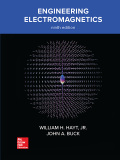
Concept explainers
The percentage of the incident power density transmitted into the copper.
Answer to Problem 12.1P
The percentage of the incident power density transmitted into the copper is
Explanation of Solution
Given:
A uniform plane wave in air
Concept Used:
First, we find out the intrinsic impedance for the given conductor (copper in our case).
For a good conductor like copper, the intrinsic impedance is,
Then, we calculate the reflection coefficient by using the below formula,
Calculation:
First, we calculate the intrinsic impedance for copper.
For a good conductor like copper, the intrinsic impedance is
For copper
And
Using
The reflection coefficient can be calculated as below:
Want to see more full solutions like this?
Chapter 12 Solutions
Engineering Electromagnetics
- Given the circuit diagram in. Find the following voltages: Vda, Vbh, Vgc, Vdi, Vfa, Vac, Vai, Vhf, Vfb, and Vdc.arrow_forwardL ✓ 30 UF 2mtt The voltage applied across 3-branched circuit of figure 2 is given by v = 100 sin(5000t+ π/4). Calculate the branch currents and total current. v 25ŹR 00arrow_forward10 mA 2 ΚΩ 2 ΚΩ 6 ΚΩ x + ww 4 ΚΩ 4 ΚΩ +1 2 Varrow_forward
- find the mesh currents and the unknown variables Vo,Ix,Va,Ioarrow_forwardTwo loads connected in parallel consume a total of 2.4 kW with a power factor of 0.8 lagging, both supplied at 120 V, 60 Hz. Knowing that one of the loads consumes 1.5 kW at a power factor of 0.707 lagging. a. Determine a power factor of he second load b. Correct the power factor to 0,9 laggingarrow_forwardDetermine the maximum power that a load connected between a and b could consume.arrow_forward
 Introductory Circuit Analysis (13th Edition)Electrical EngineeringISBN:9780133923605Author:Robert L. BoylestadPublisher:PEARSON
Introductory Circuit Analysis (13th Edition)Electrical EngineeringISBN:9780133923605Author:Robert L. BoylestadPublisher:PEARSON Delmar's Standard Textbook Of ElectricityElectrical EngineeringISBN:9781337900348Author:Stephen L. HermanPublisher:Cengage Learning
Delmar's Standard Textbook Of ElectricityElectrical EngineeringISBN:9781337900348Author:Stephen L. HermanPublisher:Cengage Learning Programmable Logic ControllersElectrical EngineeringISBN:9780073373843Author:Frank D. PetruzellaPublisher:McGraw-Hill Education
Programmable Logic ControllersElectrical EngineeringISBN:9780073373843Author:Frank D. PetruzellaPublisher:McGraw-Hill Education Fundamentals of Electric CircuitsElectrical EngineeringISBN:9780078028229Author:Charles K Alexander, Matthew SadikuPublisher:McGraw-Hill Education
Fundamentals of Electric CircuitsElectrical EngineeringISBN:9780078028229Author:Charles K Alexander, Matthew SadikuPublisher:McGraw-Hill Education Electric Circuits. (11th Edition)Electrical EngineeringISBN:9780134746968Author:James W. Nilsson, Susan RiedelPublisher:PEARSON
Electric Circuits. (11th Edition)Electrical EngineeringISBN:9780134746968Author:James W. Nilsson, Susan RiedelPublisher:PEARSON Engineering ElectromagneticsElectrical EngineeringISBN:9780078028151Author:Hayt, William H. (william Hart), Jr, BUCK, John A.Publisher:Mcgraw-hill Education,
Engineering ElectromagneticsElectrical EngineeringISBN:9780078028151Author:Hayt, William H. (william Hart), Jr, BUCK, John A.Publisher:Mcgraw-hill Education,





